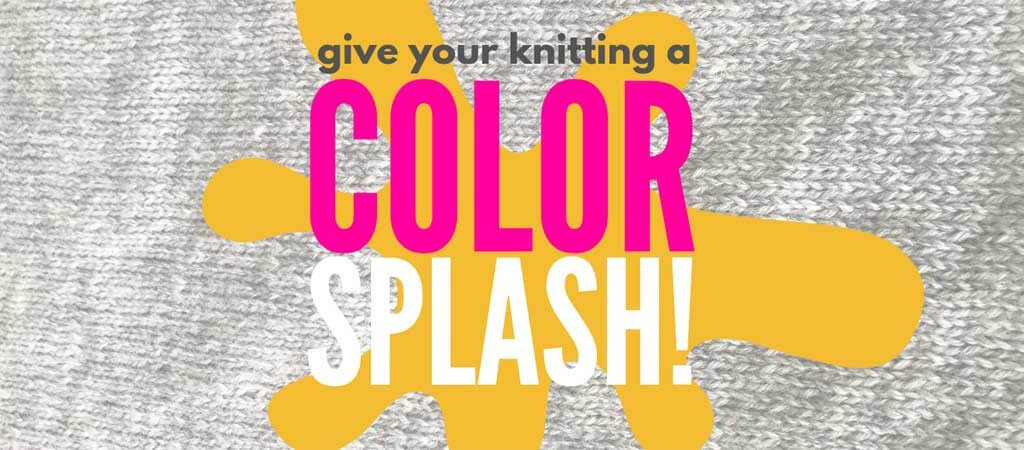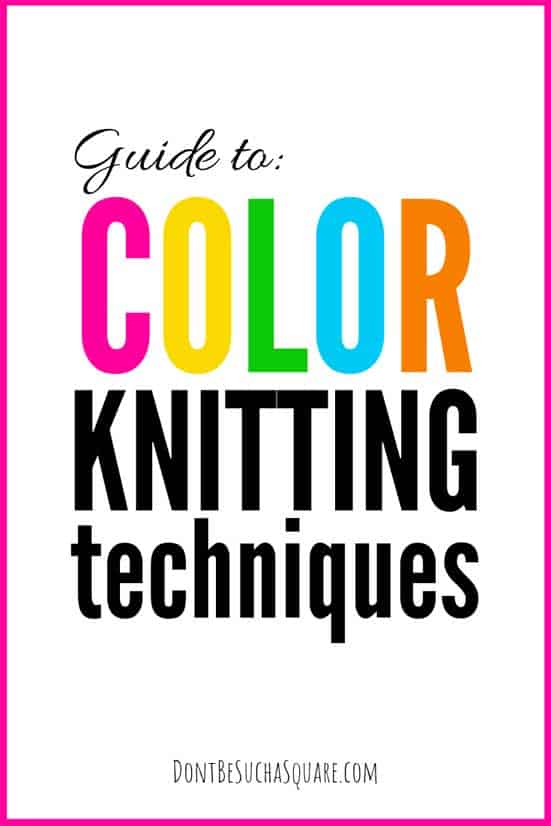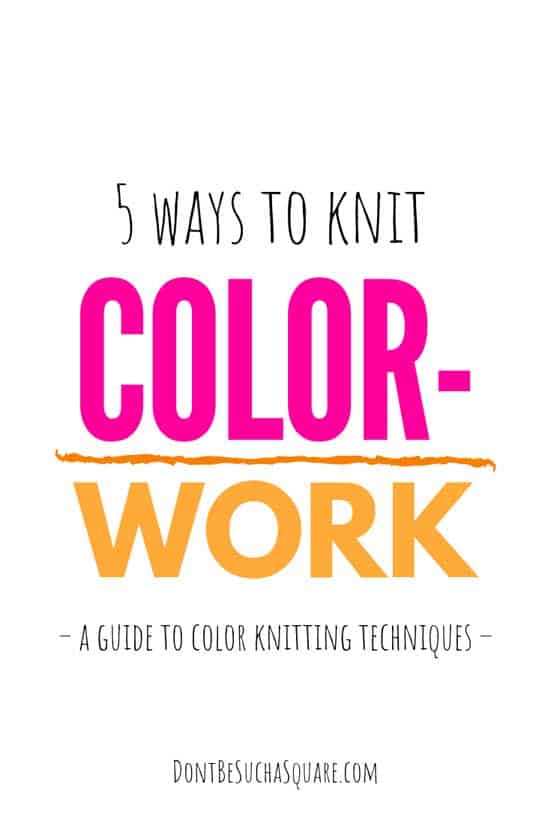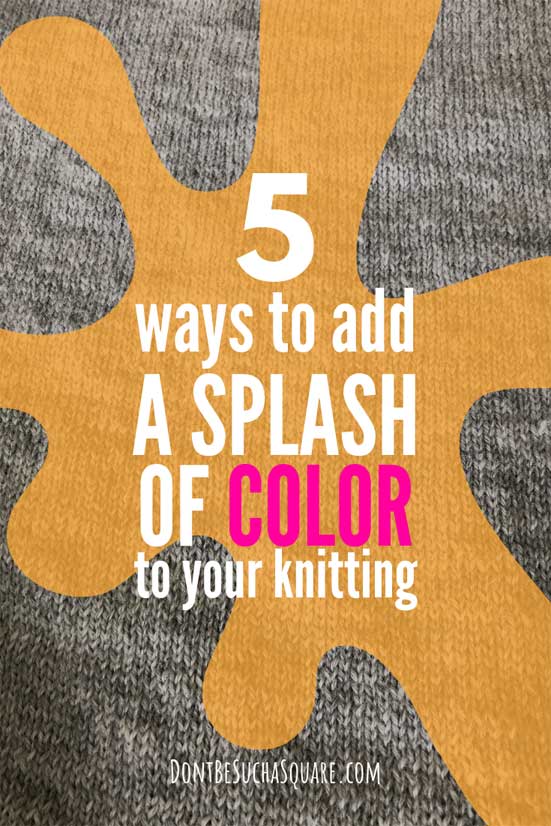
7 ways to add a splash of color to your knitting!
Knitting colorwork can be a little intimidating, don’t you think? You have to keep track of when to knit with which color and read a chart. Two or more strands of yarn dangling from your knitting can also feel a bit overwhelming.
But, you have landed on this post about color knitting techniques, so I guess you’re at least a little intrigued of all the possibilities of color knitting?
I feel you, I avoided all kind of color knitting, except for stripes, at first. Then I was looking in a knitting encyclopedia and discovered mosaic knitting, or slipped stitches as its also called. This was like opening a door for me.

The book, by the way, was Step-by-step encyclopedia of Needlecraft, written by Judy Brittain. If you ever get the chance to lay your hands on this book promise me that you bring it home with you, it’s amazing! You can learn everything from knitting techniques (like mosaic knitting!) to how to measure when sewing curtains or how to do macramé.
I found the book on Amazon. If you think it looks expensive, I understand but it’s worth every penny! And, at least when I last checked, there were some quite cheap used ones available too!
If you want to take a look at some of the patterns from the book, you can see them at Judy Brittains Ravelry-page.
A list of colorwork knitting techniques
In this post, I have listed seven techniques you can use to add some color to your knits. You just have to pick one and get started 🙂
Table of contents:
- Stripes
- Duplicate stitch
- Slipped stitches and Mosaic knitting
- Stranded knitting techniques, including Fair isle
- Intarsia, flat and in the round
The easiest colorwork technique: Stripes!
First out is the easiest technique to knit with two or more colors, let me present: Stripes!
Knitting stripes is just as easy as knitting with one color. You knit with your first color for as many rows as you need to get the height of the stripe you wish for. Then let the first color hang and start knitting with a new color.
Some tips for knitting stripes!
Knitting thin stripes:
Are you knitting flat (back and forth) and want to make thin stripes? It’s easiest to do this if every stripe is an even number of rows. This way your next color will be waiting for you at the end of the row when it’s time to change the yarn.
When knitting in the round you always come back to the same point at the end of a row. This means it doesn’t matter how many rows your stripes are, both even and odd numbers of stripes work just as well.
Carry the yarn at the side of your work:
If you knit flat, and your stripes are more than two rows it’s a good idea to carry the strand (or strands) of yarn you’re not knitting with at the moment along the side of the work.
To do this you can simply twist the waiting and the working yarn strands after every second row. with that I mean when you are turning your work at the side where your nonworking strand(s) are waiting.
The same way of carrying yarn can be used when knitting in the round. The only difference is that you twist the yarn at the back of the work (at the inside the tube you’re creating).
Knitting wide stripes:
When you knit flat and choose to do wider stripes you can carry your strands with you along the side as explained earlier. But it can look a bit untidy.
There’s also a risk that the strands you’re carrying with you get at bit too long and create loops at the side. Or the opposite, that there isn’t enough yarn in them and you get a tight and wonky edge.
To carry the yarn along the side or not?
How many rows you can carry yarn with you depends entirely off the look you wish for, the yarn you’re knitting with and how you’re going to finish off your work.
It can be a good choice to make a swatch and see how it turns out. If you decide not to carry the yarn you have two options:
- Knit five to ten stitches with both strands when you’re changing color and then cut the yarn. This works well for most yarns. But sometimes it looks a bit messy, in that case, go for the next option:
- Cut the yarn and leave a tail to weave in later with a tapestry needle.
All the above are true for knitting in the round too. If you have carried yarn inside your tube for many rows it can look a bit wonky.
If there is too much yarn your first and last stitches of the stripes can be bigger than the other stitches, due to the lack of tension. You also get loops on the inside of your work and the risk is that your fingers get caught in them when pulling on a sweater or mitten.
Too little yarn pulls your stitches and makes them too tight. It also pulls the entire “seam” where the rows start and stop and can make your work shorter on that side.
Reading tip:
––>If you’re about to dive into the world of colorwork I bet you will have good use of this post about color theory for knitters: Make your colorwork POP!
Don’t want to knit with more than one color AND have a colored pattern? Try Duplicate stitch!
Duplicate stitch is an easy and fun way to add some color to a project. You can add as much or many colors as you wish after the knitting is finished without having to manage knitting colorwork!
Duplicate stitch is also a great way to add small details to your colorwork knitting if you just want to add a few stitches in a color somewhere.
You can use the duplicate stitch to add some more personality to your knitting. Or to cover up a mistake or stains on a knitted garment.
Duplicate stitch adds a second layer to your knitted fabric and can make it a bit bulky if used a lot.

Slipped stitches and Mosaic knitting
Knitting with slipped stitches is, at least in my opinion, an easier alternative than some other colorwork knitting methods. But, the result looks like it’s much harder to do than it actually is.
When knitting colorwork with slipped stitches you knit with one color per row, which makes it really easy!
This can be done with one color to create structure, or two or more to create both structure and colorwork at the same time. I love it!
How to knit with Slipped stitches
Some of the stitches are slipped from the left needle over to the right, without being knit. These stitches bring up the color from the row before and a colorwork pattern is created. Easy as pie!
This way of slipping stitches creates a structure to your colorwork, so it’s like getting two for the price of one!
The stitches can be slipped with the yarn in back, to hide it. This means that you hold the yarn behind your work, at the wrong side, while slipping your stitch.
Or, you can slip stitches with yarn in front, which means that you hold the yarn on the right side of the work when you move the stitch. This leaves the yarn visible on the right side.
The stitches can also be slipped knitwise or purlwise, this simply means that you insert the right needle as you were going to knit or purl the stitch and then let it slip off the left needle.
Reading tip:
––> In this post: Lift, slip or pass? What’s the difference? I go through a few more ways to work with Slipped Stitches.
Mosaic knitting
Colorwork whit slipped stitches are also known as Mosaic Knitting. Mosaic knitting is actually a specific technique of knitting with slipped stitches that got popular after that Barbara G. Walker wrote about it in the sixties.
In mosaic knitting, designs can be worked on any number of stitches and are knitted after charts and the wrong side row are worked equally to the right side.
Stranded knitting
The term Fair isle is used a lot when people talk about knitting colorwork, but I don’t think we always know what’s Fair isle knitting and what’s not! Fair isle and stranded knitting are often used interchangeably, but that’s not quite right.
Fair isle is one of many stranded knitting techniques. Stranded knitting means a knitting technique where strands of yarn are carried at the back of the work.
Fair isle knitting…
- …originates from the island with the same name, a part of the Shetland Islands in Scotland.
- …never carry a strand for more than a few stitches.
- …never have more than two colors on the same row. But the design can incorporate up til ten colors.
- …motives are often geometrical, takes inspiration from nature and includes OXO patterns.
There are actually quite a few different stranded knitting techniques, some of them listed below:
- Bohus, from Bohuslän in Sweden. A technique that uses up to 6 colors per row and purl stitches, offering endless possibilities!
- Norweigan Selbu, featuring the classic eight pointed snow star.
- Lopapeysa, a style of Icelandic sweater with a special colorwork yoke.
Intarsia – knitting colorwork in big blocks!
When you want to knit big blocks of different colors, intarsia knitting is your best friend.
This way of knitting colorwork is quite easy to handle because you knit with one strand at the time, even if there are several color changes on the row.
This means that there’s no need to carry strands with you along the row. Instead, you have one strand of yarn for every color block. Which can be a little tricky to manage as they can easily get tangled together.
Intarsia knitted flat
You start your row with one strand, then when it’s time to change the color you just pick the next strand up, twist the old yarn over the new to lock them and keep on knitting. The old strand will hang there waiting for you to pick it up on your way back on the next row!
When you have turned your work, you purl back changing the colors the same way as when knitting.
Intarsia in the round
To knit intarsia in the round is a little less common and a little trickier than knitting it falt. But it can totally be done! This technique is very useful for knitting socks and mittens, and much more!
When knitting intarsia you leave the strands hanging when changing colors to pick them up on the way back. The problem is that when knitting in the round you don’t turn, and then your strand is on the wrong side of the color block the next time.
To solve this problem you have to knit back and forth using a special technique to bind the beginning and the end of your rows together.

- You knit the first row of intarsia. Turn your work over, as in flat knitting, and start the next row with a yarn over.
- Purl your way back to the end of the row, picking up and working your colors according to the pattern. At the end of the row, it’s time to bind the start and end of the row together.
- Purl the last stitch of the row with the yarn over you made at the start of the row. (If you have a stitch marker placed at the start of the row: lift the last stitch, remove marker, put the stitch back at the left needle, purl it together with the yarn over and put the marker back)
- Turn your work, start your row with a yarn over.
- Knit your intarsia row.
- Knit the last stitch of the row together with the yarn over you made at the start.
If you have rows with only one color you can knit these as usual, without turning.
